
The life blood of any successful museum is regular collection and display of fresh material. The Foresters Heritage Trust is fortunate in having items coming in from a number of diverse sources to add to the extensive collections built up by our predecessors over the years. We are always pleased to hear from any individual or organization that might wish to donate an object, or documentation, to the collection.
Former and existing members have been a major source of providing us with material, and with the establishment of a permanent facility, this is something that many are now keen to contribute to. Having guarded something safely, they now have confidence in our ability to provide a secure home for their treasured items.
Similarly, relatives of departed members seeking a home for an ancestor’s engraved jewel, Past Chief Ranger’s sash, etc., regularly come forward with items that they are only too pleased for the Trust to have, hopefully displayed, but if not, then at least stored safely.
With the acceptance by the museum community of the Trust, and its objectives, we are pleased to be able to provide an appropriate home for friendly society material that, perhaps, does not fall within a museum’s collection policy parameters, or is deemed to be more suitable for retention by the Trust.
To enable the greatest number of people to have access to recently added items we have decided to create this page, on which images, with suitable text, can be displayed. Here visitors to the website will be able to keep in touch with newly added, or perhaps rediscovered items.
Subject Headings Banners |
Further Reading None Known |
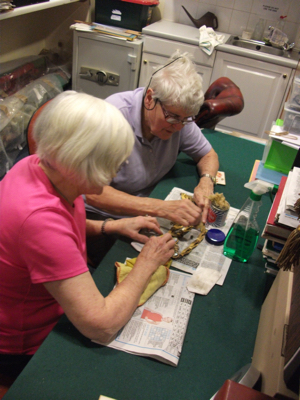 |
District chains of office re-discovered We were delighted to receive recently several ornate chains of office worn by the District Chief Ranger (Chairman) in various parts of England until Districts were abolished at the end of 2002. These included chains and pendants of the Bucks & Middlesex District, Burton-in-Trent District, Cannock & Rugely District, Leicester District, Northants, etc., District, South London District, Stafford District, and the Walsall District. The first job of our volunteers Elizabeth and Maureen was to examine each chain in turn, painstakingly recording the names of members holding annual office engraved on the individual platelets. The resulting lists are a fine record of service, and in the absence of documentary evidence of post holders, provide a unique source of information. Whilst most of the chains and their pendants were in sound condition, one in particular was being affected by discolouration. This afforded the opportunity for our volunteers to get out the cleaning materials and, as shown in the accompanying picture, restore the chain and pendant to its former glory. Along with the other chains in the Trust’s collection they will not be on open display but be placed in a safe which itself is in a secure location. |
|
| Back to Top | ||
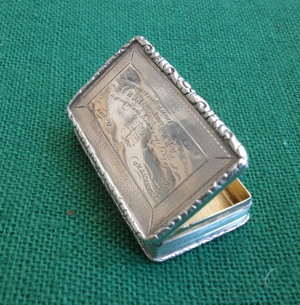 |
Inscribed silver snuff box dated 1836 This delightful item was acquired recently by the Trust in one of the rare instances of purchasing objects for addition to the Museum & Archive collection. The small box, which measures approximately 2?inches by 1?inches by ?inch (6.5 cm by 3.5 cm by 1.5 cm), has a lid inscribed ‘Presented by the members of the Court of Ancient Foresters No. 323 to R B Thompson as a testimony of their respect for his services, Feby 1836? The wording is set above and below an outline representation of the Order’s Arms. The box thus dates from just 18 months after the formation of the Ancient Order of Foresters in August 184. It provides the earliest evidence we have that presentations of this sort were made at the period to past Officers, in particular the Court Chief Ranger, or Chairman. The first written record currently known is from November 1836, when the presentation of ‘a silver snuff box?to Bro John Evitt, Past District Chief Ranger of the Manchester District, was recorded in the Foresters?Miscellany. Bro Thompson’s Court was based in Lancaster. Its full name and number were Court “Duke of Lancaster? No. 323 of the AOF. Prior to transferring allegiance to the newly created Ancient Order, the Court had belonged to the Royal Foresters, where it had the number 286. It appears to have been founded in 1833, so that Bro Thompson was one of its earliest office holders. The snuff box is hallmarked silver with a Birmingham Assay Office mark, the mark of the manufacturer, Francis Clark, and a year mark for 1835. |
|
| Back to Top | ||
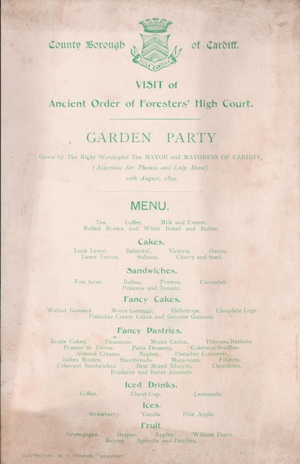 |
Cardiff 1899 AOF High Court menu card and programme We were delighted to receive two original documents from the Cardiff HCM of 1899. One was Programme for the Reception for delegates hosted by the Mayor and Mayoress of Cardiff, Alderman Sir Thomas and Lady Morel, at Cardiff Castle in the evening of August 9th. The Reception was held in the Reference Library, where guests were treated to a ‘Selection of vocal music?by the Cambrian Glee Society. An outdoor Promenade was available on the Roof, where the entertainment was provided by the Hungarian band, playing a selection of music. The library, together with the Museum and Art gallery were open for inspection. On the following day, the Right Worshipful Mayor and Lady Mayoress gave a Garden Party, the menu for which is illustrated. Delegates could well have felt entitled to these sumptuous events, affording as they did some opportunity for light relief to the business of High Court. Attendance at the Cardiff High Court, which lasted from the 7th to the 11th of August 1899, was the largest up to that time, some 839 delegates attending, with 650 from Districts, 164 from Courts in a District, and 25 from Courts not in a District. Possibly the big attraction was the main business, that of completely re-drafting, codifying and re-arranging the General Laws of the Order, something which had not been attempted for many years. The result was a reductionin the number of Laws from 122 to 74. |
|
| Back to Top | ||
 |
Oddfellows (MU) membership certificate The accompanying illustration shows a colourful Oddfellows (Manchester Unity) membership certificate issued to Bro Millard, of the loyal Cumbria Lodge, No. 6916 of the Oddfellows South London District, in 1919. Comparison with a similar certificate dating from 1904 shown in Daniel Weinbren’s excellent book, ‘The Oddfellows, 1810 ?2010? reveals that little change took place in the design of the pictorial element over the period. Some slight modification in the form of words at the base of the certificate is evident. No reference appears on the certificate as to the designer or engraver of this handsome piece of artistic work, however the reference to its being ‘copyright-entered at Stationers Hall?offers scope for further research into these aspects of the certificate. |
|
| Back to Top | ||
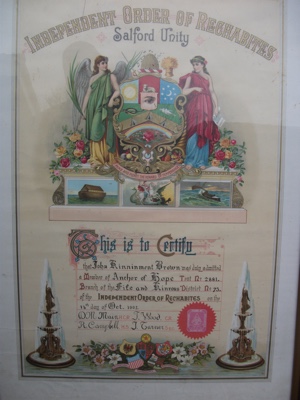 |
Rechabites membership certificate The Independent Order of Rechabites (Salford Unity) came into being the year after the emergence of the Ancient Order of Foresters, ie 1835. This was an Order based on the principles of, as a late 19th century historian wrote, ‘temperance, or rather, total abstinence.? By the mid 1880’s the Rechabites had some 58,000 adult members in the UK, this figure increasing to 205,000 by 1905, when it was the third largest friendly society Order after the Oddfellows and the Foresters. Shown here is a membership certificate from October 1907 awarded to John Brown from the ‘Anchor of Hope?Tent, No. 2881, in the Fife and Kinross District. The initials of the officers shown can create confusion. In the Rechabites HCR stood for High Chief Ruler, rather than as in the Foresters; High Chief Ranger. Similarly each Tent (branch) had a Chief Ruler (CR). The names of the designer and engraver are absent, however once again reference is made to it being a copyright design. |
|
| Back to Top | ||
 |
Portsmouth Young Leaguers?Union banner Whilst friendly societies were there for the needs of many working class people of the late 19th and 20th centuries, there were others who fell outside their ‘safety net,?The needs of thousands of, in particular, children, were recognised by caring elements in society. On such organisation was the National Children’s Home and Orphanage, originally formed in 1869 by Dr Thomas Stephenson, Francis Horner and Alfred Mager. In 1899 the Young Leaguers?Union (YLU) was established as a fund raising body for the Home, drawing on the involvement and enthusiasm of better placed youngsters. It was a successful venture, with, for example, in c1908 some ?000 being raised by the Young Leaguers efforts. The challenge banner illustrated comes from the Portsmouth District Young Leaguers, probably dating from early in the 20th century. The banner has no maker’s name or location to show where it was manufactured. It is made of silk, painted with inscriptions, the backing being plain. Further information about its origins would be welcome from anyone knowing such details. The National Children’s Home continues today as the charity ‘Action for Children.?/p> |
|
| Back to Top | ||
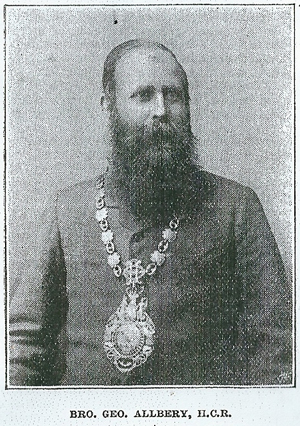 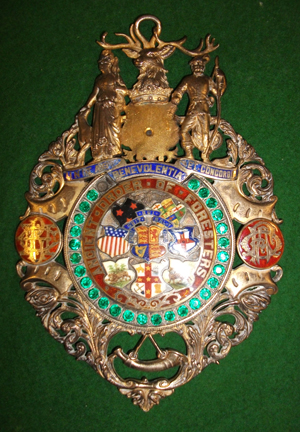 |
Original AOF High Chief Ranger's Badge and chain In February 1895, in the Pavilion at Brighton, Sussex, 'a room well filled with ardent and enthusiastic Foresters' was the venue for the presentation of a very special AOF badge and chain. Up to that time the High Chief Ranger (HCR) of the Order, the national chairman, had worn a simple green neck ribbon, as had his fellow Executive Council (EC) members whilst in office. To add dignity to the post, members of the Foresters in Brighton, which in 1894/95 was the location of the annually elected EC, decided to present an ornate badge, to be suspended from a chain of manacle links and shields. The first wearer of this imposing piece of regalia was Bro George Allbery, HCR for 1894/95. The badge comprised various illuminated shields, including the Royal Arms of England, and those of the United States, Malta, the Australian colonies, India, South Africa, Canada and the West Indian islands. These were set in a circle of emeralds and the Arms of the Order. Both the badge and the chain were made of 'massive sterling silver, richly gilt' and it was considered by a contemporary to be 'the most handsome article yet produced for a purpose of this kind.' The original Badge and chain were made by the well known regalia firm of G Tutill of City Road, London. Over the years additional links and shield were added to the chain making it an extremely heavy item to wear. At some point the Badge and chain ceased to be used, and for many years their whereabouts was unknown. Recently they has come to light again and deposited in the Trust's collection. For security reasons they is kept in a safe, but can be shown to visitors on request. The two illustrations show, firstly Bro Allbery proudly wearing the chain in February 1895, and secondly the badge and chain as it is today. |
|
| Back to Top | ||
  |
Easter in Paris Fund raising for deserving causes is so much a part of life in Britain in the early 21st century that it can be forgotten that friendly society members were for many years pioneers in the area of benevolent support. Until recently a useful facility, established in late Victorian times, was available in the Friendly Societies Convalescent Home at Herne Bay. This had an interesting history, and a small but quite intriguing interesting aspect of this has come to light recently in the form a leaflet with covering letter sent to Foresters Courts throughout the UK advising of an 'Easter in Paris' organised by the Homes Committee. 'With the object of benefitting the funds of the Homes' (there were at the time two in Kent, one in Dover the other Herne Bay) 'and at the same time providing pleasure' the Homes' Committee of Management hit on the idea of running an excursion to Paris over the 1906 Easter holidays. The excursion, the cost of which was ? 7s 6d, included rail and steamship fares, hotel accommodation, service, gratuities, drives, etc., and the benefit of 'efficient conductors.' Leaving London on the evening of Thursday, April 12th, the excursionists were due to arrive back in London 'in time for business on the following Tuesday morning.' Two alternative channel crossings were offered. One was using the Mail Steamer from Newhaven to Dieppe, the other a Mail Steamer from Dover to Calais, at a cost of 4s 6d (22p) extra. Whole day visits to a full itinerary of places of interest were arranged for Good Friday and Saturday, whilst on Easter Sunday, parties were arranged 'to visit some of the magnificent Services held on this day.' Monday was allotted to independent action. |
|
| Back to Top | ||
 |
Yorkshire Foresters Convalescent Homes Located in Summerfield Road, Bridlington, the present Yorkshire Foresters Convalescent Home provides a welcome source of accommodation for Foresters and their families in need of convalescence or recuperation after illness. The Homes are open during a set period from Spring to Autumn each year. Accommodation is varied and the Homes continue to meet a need. The idea of providing a Convalescent Home in Yorkshire originated at the Sheffield Annual Meeting of what was then the Yorkshire Foresters Orphanage. Tackling the 19th century social problem of working men's widows and orphans' was one of the great strengths, now sadly forgotten, of the friendly society Orders. Yorkshire Foresters addressed the problem, in part, by endeavouring to establish an Orphanage, land in St John's Avenue, Bridlington being purchased in the late 1890's for the purpose. The decision to attach a Convalescent Home to the Orphanage resulted in the chief corner stone of the building being laid by Bro R S Kirk, an honorary member, on 23rd February 1899, with the weather being 'bright, sunny and cheerful' and everything going off 'with éclat.' The ceremony included the laying of a number of 'Helping-stones' by representatives from supporting districts and Courts. Bro John Beaumont was the Sheffield & Hallamshire nominee, and The Foresters Heritage Trust trustees were delighted and grateful early in 2013 to receive from his descendant, the inscribed commemorative trowel (see illustration) presented to him on the occasion. Associated with a write-up of the occasion in the Foresters' Miscellany, the trowel is on display in The Foresters Heritage Trust's Museum & Archive at Southampton. |
|
| Back to Top | ||
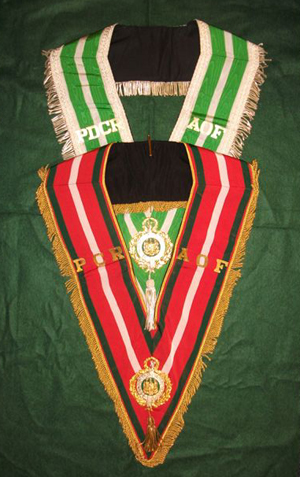 |
New Zealand Foresters heritage We were delighted to hear from a former member in New Zealand that, now living in England, she would be wiling to donate to the Trust's collection collars, jewels, and a photograph associated with members of her family when she was in New Zealand. Val Ivatts family played an active part in the Auckland District. Forestry in New Zealand was, in common with most English speaking countries, a significant part of working peoples lives from the late 19th through to the mid to late 20th centuries. Val visited England towards the end of 1967, and the Foresters' Miscellany records and illustrates her attendance and speaking at the London United District's 500th meeting. The donated collars (See illustration) are in almost perfect condition and are of astonishing quality. No maker's name is shown, so they could well have been locally made items. The jewels, on the other hand, were of the approved style and design available in the UK. One bears the inscription CT "ANZAC", No. 9383 PRES. TO BRO O.R.NELSON PCR 8.12.34. Trustees are grateful to Val for donating these items to the Trust's collection and for providing memories of Forestry in New Zealand. |
|
| Back to Top | ||
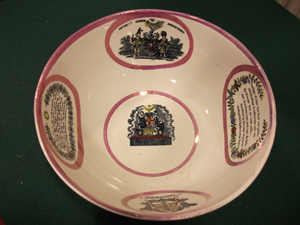 |
Sunderland Ware bowl c.1840's Acquisition of a distinctive Sunderland ware bowl was made through the much appreciated interest, effort and generosity of a Foresters Court Secretary. This rare, if not unique, item bears the arms and mottos of the Ancient Order of Foresters, the Independent Order of Oddfellows (MU) and the Freemasons. As a symbol of our efforts to encompass the whole range of friendly society history, this bowl is of tremendous importance. At some 12 inches (31 cm) diameter at the top of the bowl this is one of the largest ceramic items acquired by the Trust, and will be kept securely, being made available for examination under controlled circumstances. The Trust now has several Sunderland ware pieces, most bearing the Foresters' Arms, and the fascinating rhymes accompanying the illustrations. |
|
| Back to Top | ||
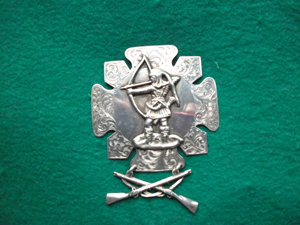 |
AOF Archery medal - 1861 A further item purchased was an inscribed and hallmarked silver medal of an archer. This linked perfectly with the FFS support for the Team GB Archery at the Olympics and Paralympics. It was also highly appropriate to accompany a commissioned article on the connection between archery and the AOF, to be published in the Journal of the Society of Archer-Antiquaries. Awarded to Bro W Branning on 21st September 1861, anyone knowing details of its origins or local connections is invited to contact the Honorary Secretary. |
|
| Back to Top | ||
 |
Banner Book There have been a number of really interesting acquisitions for the Archive this year. Outstanding amongst these was a 'Banner Book', from Court "Abbey Foresters", No. 1940. In this are listed the details of occasions during the 1880's and 90's when the then newly acquired Court banner was displayed, revealing a hitherto neglected facet of Court life at this period. The type of event and institution tended to be one local to Kilburn, where the Court members met for many years. Amongst the occasions when the banner was paraded were for a Demonstration in favour of the Hospital for Paralysis and Epilepsy, St Johns Wood, on 26th June 1887; in connection with a Church Parade in favour of the Kilburn Dispensary and Children's Hospital, Paddington on 8th July 1888 ; the removal of Court "Effort", from Cambridge Street to Chapel Street, on 18th December 1888. In addition to the Banner Book two marching banners were deposited by Court "Abbey Foresters", both relating to Juvenile Foresters Societies. One of the occasions at which the new Banner was shown was a concert at the Kilburn Town Hall in favour of the United North Western District Juvenile Foresters' Society. |
|
| Back to Top | ||
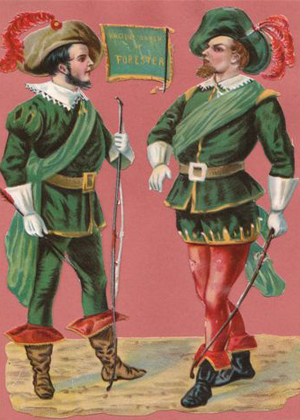 |
Foresters scraps Victorian scrapbooks make regular appearances on television antiques programmes, containing all sorts of fancy pieces. Amongst a collection of material recently sent in to the Trust by a private donor were items not seen before. These were Foresters scraps, two costumed Foresters characters in traditional dress, together with a pennant bearing the inscription 'Ancient Order of Foresters'. The existence of these items shows just how much the Foresters was an instantly recognisable part of popular culture during the 19th century. Anyone having similar items, perhaps of a different design, is invited to contact the Trust with details. E-mail to enquiries@aoforestersheritage.com |
|
| Back to Top | ||
 |
Foresters Salute the soldier This intriguing and probably rare item of second World War memorabilia reached us recently, in the form of a colourful Certificate of Honour awarded to the members of Court "Jane Stead", no. 8250, (see attached photo). This female only Court, based in Cambridge, had made its contribution to the war effort through the stirringly named 'Salute The Soldier' national savings campaign of 1944. When founded in 1893, Court "Jane Stead" was one of the first all female Courts to be established in the Order following the decision at the 1892 High Court Meeting (annual national delegates conference) to admit women members to the AOF. One of the strongest advocates of female membership was the Permanent Secretary of the Order, T Ballan Stead, so it was quite appropriate that this Cambridge Court, where that year's national Executive Council, and hence Bro Stead and his family were residing, should bear the name of his daughter, Jane Stead. |
|
| Back to Top | ||
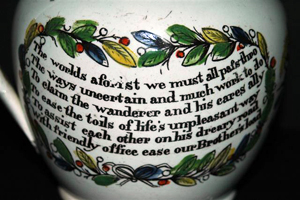 |
Royal Foresters jug Acquisition by purchase is something FHT trustees only undertake when a particularly significant item becomes available. Then, and only then, is some of the money generously donated by Courts and individuals used for developing the collection. This inscribed, hand coloured, Royal Foresters jug, illustrated, came into that category. Offered to us by a non-member who had seen our website and learned of the Trust's work of preserving Foresters heritage, the relevance to our collection is evident. The Royal Foresters, out of which the Ancient Order emerged in August 1834, had a history of its own going back to 1813. Thus this jug, although undated and bearing no maker's mark, is certainly of some age. As important as the age was the condition which appeared to be excellent. Prior to the addition of the jug to our collection we only had one item of Royal Foresters pottery, a decorated and inscribed mug, so we are delighted to now have this attractive piece to display at the Museum & Archive. |
|
| Back to Top | ||
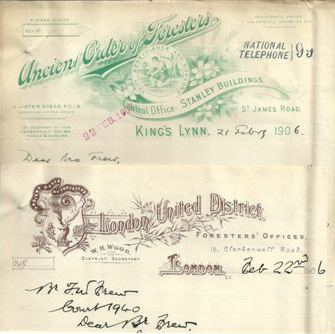 |
AOF Female Court origins and history From Court "Abbey Foresters", No. 1940, we were pleased to receive their PCR Honours Boards, bearing the names of all those who had held the position of Court Chief Ranger since 1845, a priceless record. Accompanying this was the Court Dispensation, together with the Dispensation for female Court "Abbey Foresters", No. 9169. This ties in perfectly with a sheaf of correspondence also received referring to the origins of the new Court. Amongst the gems of information is that members hoped to get the number 9140, a reordering of 1940, for the female Court but due to the time taken to set the Court up, this number had already been used when it was approved. That paperwork is also interesting as providing us with examples of the style of headed notepaper in use 100 years ago. The Executive Council was still moving annually from place to place, and we have copies of EC headed paperwork from its sojourn at Kings Lynn in 1906. The technological advances of the time can be seen from the overprinting of a National Telephone number, 99. Accompanying the EC item is a marvellously embellished piece of headed paper from the London United District. |
|
| Back to Top | ||
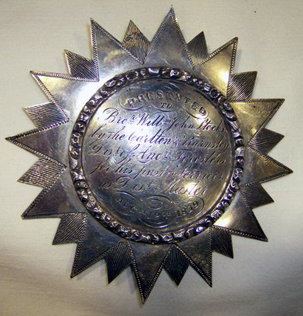 |
AOF Medals Trustees were pleased and grateful to receive recently from a generous supporter of the Trust what has been identified as the oldest AOF medal yet located. With a second medal of slightly later date, they originated from the Barnsley area of the West Riding of Yorkshire. It was on 12th August 1839, with the presentation of the multi-pointed, star shaped medal, that the presentation of the medal took place, with the recipient being named. The inscription read ‘Presented to Bror Willm. John Stocks by the Carlton & Barnsley Dist. Of Ancnt. Foresters for his past services as Dist. Master August 12th 1839.’ The term ‘District Master’ was effectively declared obsolete at the AOF annual delegates meeting held at Stalybridge in August 1837, ‘District Chief Ranger’ becoming the accepted title for the post of Chairman of an AOF District. Thus the implication may be that Bro Stocks had served in that capacity at an earlier period in the District’s history. William John Stocks was a farmer at Carlton, not far from Barnsley, where he was a member of Court “Lord Wharncliffe”, No. 288 of the AOF. He had probably been a member of the Court since it was founded as a Royal Order Court, prior to the establishment of the AOF in August 1834. At that time he was named as one of the founders of the Court. |
|
| Back to Top | ||
 |
Roberts Challenge Shields (1) Membership Competitions were notable features of 20th century Forestry. These gave Order members in Courts throughout the British Isles the opportunity to actively contribute to the fundamentally important issue of attracting new members. In 1929, the then High Sub Chief Ranger (HSCR) of the Ancient Order of Foresters, Bro. Joseph Roberts announced his intention to donate two shields to be competed for annually in the run up to the forthcoming centenary of the Order in 1934. One was for the Court recruiting the highest number of new adult members, the other for the Court achieving the greatest percentage increase in adult membership. At the Cardiff High Court meeting of August 1931, Bro. Roberts, now High Chief Ranger made the first presentation of the Shields. Winner of the numerical shield was Court “Perseverance”, No. 3278, based in Kentish Town, north London. The accompanying image shows Bros John Burrows, the long serving and much respected Court Secretary, W F Clark, and an unidentified Court member at the HCM following the inaugural presentation of the shield. Winner of the percentage shield was Court “Royal Victoria”, No. 2288, from Singleton in Sussex. |
|
| Back to Top | ||
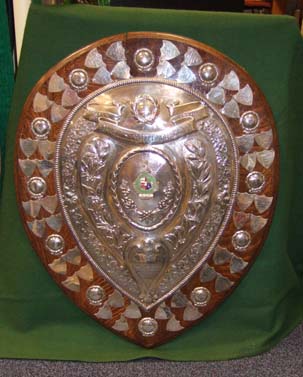 |
Roberts Challenge Shields (2) Over the years the format of membership competitions was adjusted to meet changing circumstances. The Financial Services Act of 1987 brought fundamental changes to the activities of friendly societies, with one of its consequences being that the existing forms of recruitment became ‘inappropriate’. Courts no longer competed for the Roberts shields. Under the legislation, ordinary members were forbidden to recruit, and only those qualified, credited with the title “authorised person”, could participate. One Roberts shield was subsequently awarded to the authorised person securing the largest amount of premium income in a year, the other for the individual recruiting the largest number of adult members. At the 2000 HCM it was announced that membership Competitions were to be suspended, The last winner of both the Roberts Shields was subsequently given permission to hold them indefinitely. With the formation of the Foresters Heritage Trust’s Museum & Archive, their permanent display became possible, and trustees are grateful to Daphne O’Connell for passing them to us. Illustrated is one of the shields in its final state replete with the names of Courts and individuals who achieved great things for the Order during the 20th century. |
|
| Back to Top | ||
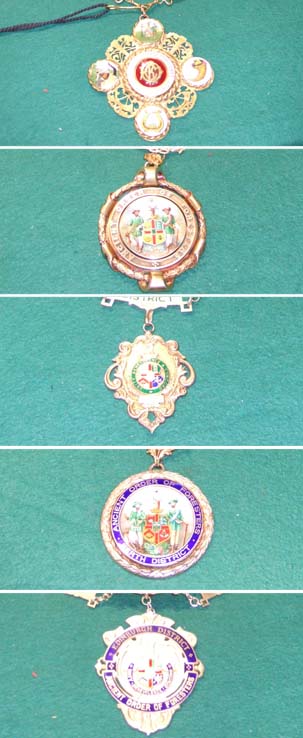 |
AOF District chains from Scotland Trustees were delighted to receive, through the good offices of Pat Stewart, a fine collection of five AOF Scottish District chains. Each with its decorative pendant and links is an attractive object. Equally important is their significance as a lasting testimony to Order members who achieved the distinction of serving as District Chief Ranger (DCR) or chairman, in their own location. The Glasgow District chain dates from 1908/9. It was presented by members of Court “Heatherbell”, No. 5599, to commemorate the achievement of one of their members, Bro. John Brown, on being elected High Chief Ranger (HCR) of the Order. Names of PDCR’s up to 1949/50 are recorded. The chain is of the design introduced by the EC to the design of Bro W C Eaton in 1903. The Greenock District chain of office dates from 1927, being the first chain that the District possessed, and replacing the DCR’s Ribbon which had been used for ‘fully thirty years.’ The chain was supplied by the EC, being of chaste design, with the centre medallion bearing the words ‘Greenock District – AOF’. On the reverse of the pendant is the inscription ‘Greenock District Instituted 1842.’ The first DCR to wear the new chain was Bro. W E Graham and on it are recorded DCR’s up to 1940. At a celebratory supper held in April 1930, Bro. John K Taylor, a past member of the Executive Council, presented the Perth District chain to commemorate the fiftieth anniversary of the founding of the District on 12th April 1880. Bro. William Pickard had the honour of being the first DCR to wear it. All of his predecessors are recorded on the reverse of the pendant. The last name shown on the chain is that for 1953/54. On 23rd January 1932, members of Court “Standard”, No. 4604, which met in Newcastle, presented a chain of office for the Edinburgh District. Bro J H Carmichael, of Court 4451, the DCR 1932/33 is the first name on the links with those of subsequent DCR’s for the next 40 years are recorded, up to 1974/5. The Trust also has in its collection a number of English and Welsh District chains of office, all providing similar useful information about members who served as District Chief Rangers. |
|
| Back to Top | ||
 |
Presentation clocks The culture of friendly society Orders gave members the opportunity to acknowledge the efforts of those performing outstanding duties. In addition to the recognised forms of inscribed medals or jewels, sashes, etc., sometimes more personalised items were awarded. Foremost amongst these were presentation clocks. Sometimes elaborate and ornate, sometimes functional, each was an expression of feelings of respect. As a tangible record of a member’s commitment, often inscribed on a brass plate on the front of the clock, these are significant items, in terms of both family and Forestric history. The clock illustrated was presented to Bro C F Beaven in 1951 by fellow members of Court No. 2448 ‘for services rendered including 40 years as Trustee.’ There were at least three generations of the Beaven family active in Forestry throughout the 20th century and our thanks go to Mrs P. Beaven for donating this clock, and other items, to the Trust. Many clocks have finished up a long way from home. An enquiry to the Trust about an inscribed presentation clock from its present owner in the USA, revealed its origins in the English Home Counties in the late 19th century! |
|
| Back to Top | ||
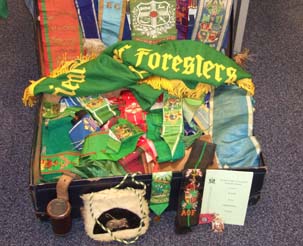 |
Puttick Collection One of the most generous donations of privately collected friendly society objects has been made to the Trust by Edgar Puttick, and his wife Pamela. Both were formerly very active in the Brighton District of the AOF. Over many years they built up a diverse collection of sashes, ribbons, collars, aprons, jewels, badges, metal claps and embellishments. These relate not only to the AOF but also other Orders, such as the Oddfellows (MU), and other mutual societies. The clasps and embellishments came to the Trust ready mounted on a display board, a consequence of Edgar’s talking to and showing his items to interested groups in the Brighton area. The presentation board has been incorporated in the Trust’s display, complementing the existing display of Court Officers sashes. |
|
| Back to Top | ||
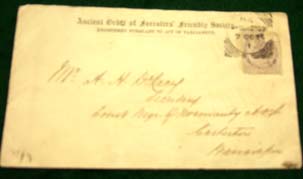 |
A New Zealand Court Secretary A short while ago a descendant of an emigrant to New Zealand contacted the Trust to see if we had any details if his ancestor. Nothing unusual in that, we are often approached by enquirers from Australia, Canada and New Zealand. Although the Trust holds no original source material from outside the UK, we were able to track him down from the annual Foresters’ Miscellany. Andrew Horace De Lacey, who was born in Guernsey, emigrated to New Zealand in 1873. He became Secretary of AOF Court “Marquis of Normanby” at Carterton, New Zealand in 1887, holdng the post until 1893. In June that year he was tragically killed, aged 48. Whilst he was Secretary the Court had its own premises, the Foresters Hall, Belvedere Street, where the 60 to 70 members met to conduct business. . Quite amazingly, a postcard (see illustration) from over one hundred years ago addressed to Bro. De Lacey, as Court Secretary, recently came into the possession of the Trust, as a result as a generous donation by one of our regular supporters. We thus have a tangible link with an individual identifiable in both Forestric and family history. |
|
| Back to Top | ||
 |
Female Foresters in the USAAn indication of the difference in approaches to female membership taken by AOF members in the UK and USA is reflected in the differing structures adopted for female membership. In the UK, from 1892, all-female Courts were authorised, with, from 1898, mixed Courts also being approved. In north America, the Subsidiary High Court (SHC) for the Atlantic, Central and Southern States, the SHC of the Pacific Coast, and the SHC of Canada, established the aptly named Companions of the Forest to accommodate female members. Around 1906, however, the SHC of the AC&SS established a new structure, called the Maid Marian degree. The accompanying illustration shows a Maid Marian degree recognition badge. As in local branches of the Companions of the Forest these were called Circles. Slow to increase in number, in 1909 the “Pride of Ansonia” Circle was established with a meeting place at the Masonic Halls, Main Street, Ansonia. The illustration shows a ribbon and badge from the Ansonia Circle. Generously donated to the trust by one of our trustees these two items add to our currently sparse collection of non-UK related Forestric items. |
|
| Back to Top | ||
 |
Foresters Dance card During the 1840’s and 50’s meeting the often pressing needs of widows and orphans’ was something dear to the hearts of many friendly society Order members. In the Foresters’ many local Funds were established by Courts and districts. The money needed to support a Widow and Orphans Fund required all sorts of fundraising activities to be undertaken. Often fetes were organised, most famously the annual London United District Crystal Palace fete which raised money for their W & O Fund from 1855. The accompanying Dress Ball dance card tells us a little of the efforts made by members of Court “Little John”, No. 1517 of the AOF in Birmingham. On Tuesday 28th December 1852, under the patronage of the Mayor, H Hawkes, Esq., a full programme of 28 dances was presented at the Town Hall, in aid of the Courts Widows and Orphans Institution. Polkas, Quadrilles, Valses amongst others offered an energetic evening for those supporting the Ball. Providing the music was Messrs Hayward and Tilley’s Quadrille band, which consisted of between thirty and forty performers. Hopefully well supported, things were not quite all that they seemed. Court No. 1517 was, at the time of the Dress Ball, suspended from the Order for non compliance with the rules of the Birmingham Midland District, of which the Court was a member. Suspension had taken place in 1849, so the members of the “Court” had clearly continued to operate as if nothing had affected their status. As far as can be established, it was never reinstated. |
|
| Back to Top | ||
 |
What’s in a name? It was not uncommon for members of a Foresters’ Court at some point subsequent to the Court’s foundation to change its name. We seldom have records to show why this was done, so often it is a matter of speculation as to reasons. Equally we very rarely have any documentation indicating the precise moment when the change was made. The accompanying illustrated document is therefore something of a rarity. This is a letter of authority from the Executive Council of the AOF issued by the Permanent Secretary, Thomas Ballan Stead, advising of a name change in February 1893. Court “Admiral Massingberd”, No. 6961, was granted a dispensation in late 1882 for meetings to be held at Great Milton in Oxfordshire. Admiral Vincent Amcotts Massingberd is, perhaps, a name not now readily recognised by many, other than naval history anoraks. Born around 1822 he had, it appears, a successful career in the Royal Navy. He died towards the end of 1889, and subsequently the link between the name and the Court weakened. Someone, we don’t know who since no Court records have survived to be deposited with the Trust, suggested a name change; in February 1893, the Executive Council, based that year in Bristol, authorised the name “Ashurst” for the Court, and Thomas Ballan Stead, the Order’s Permanent Secretary, sent out the letter shown here. Questions a’plenty are raised, but at least we can observe how one small part of the process of Order administration worked as a result of the survival of this 116 year old document. |
|
| Back to Top | ||
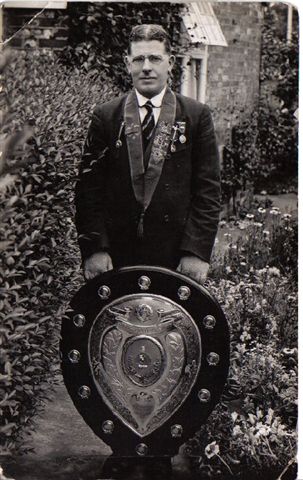 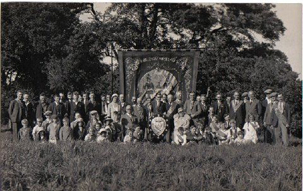
|
Roberts Challenge Shields (3) We are delighted to have received two images in connection with our earlier accounts of the introduction of Forestric awards for efforts made to increase membership during the 20th century. They come from the grand-daughter of Frank Alfred Pilcher, in 1931 Chief Ranger of Court "Royal Victoria", No. 2288, at Singleton in Sussex, England. The Court won the inaugural completion for the greatest percentage increase in members. The upper picture shows Bro. Frank Pilcher. It was he who accepted the Roberts Challenge Shield Shield at High Court and brought it back to Sussex. He was met off the train in Chichester and the shield was paraded through the city. He is still remembered fondly by members of the local AOF branch and was also a Parish Council Chairman. Bro Pilcher is shown with the shield in the back garden of his home Hill View, Singleton. The lower picture shows Court members and children, including Bro Frank Pilcher and his son Frederick Pilcher gathered in front of the Court banner, in Glebe Meadow, Singleton after the parade. We are pleased to display these photos as a lasting testimony to all those members who throughout the 20th century, made strenuous efforts in the name of the Ancient Order of Foresters, in particular Bro. Frank Pilcher. |
|
| Back to Top | ||
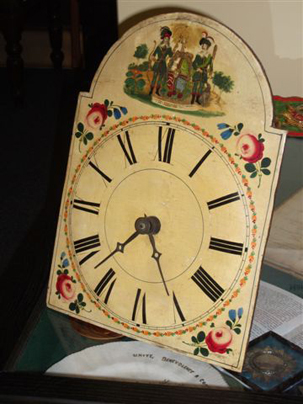 |
19th century clock bearing the original Foresters Arms Thanks to the interest of a clock collector, unconnected with the Foresters, we are delighted to have acquired for the collection a charming wall clock, decorated with a hand painted depiction of the original Foresters Arms, as in use from 1834 to c. 1892. The story behind its addition is that the collector, seeing the clock advertised for sale at auction in Surrey, England, took the effort to seek out information about the illustration, which was not mentioned in the auctioneer's catalogue, and located our website. An e-mail to the Trust instigated urgent consultation amongst trustees to decide about bidding, and this resulted in success at auction just three days later. Within a week, the clock was paid for and in the Trust's possession. The clock dates from the mid-19th century and was made in Bavaria, in what is now Germany. It is described as a continental wall clock with two train movements. There is no inscription as to maker or owner, nevertheless the well preserved representation of the Foresters Arms makes this a significant addition to our growing collection, and our thanks go to the considerate well wisher who brought it to our attention. |
|
| Back to Top | ||
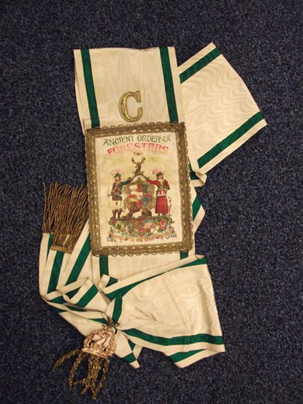 |
John Tudor's sash The death of the Rev John Tudor in August 2009 brought to an end a long connection with the Foresters. His impressive record of attending and preaching at the annual High Court meeting began in Ayr in 1980, when he took as his theme 'bridge-building'. For nearly thirty years he performed the role of High Court Preacher almost continuously, making his last appearance at the 2008 High Court at Scarborough. He was also actively involved with the fund raising Charity Stewards UK Trust, a dedicated body of Foresters who did much to raise funds for a wide range of charities. The Foresters Heritage Trust was honoured to recently receive from Cynthia, John's widow, the sash he wore in his official duties as chaplain to the AOF. It is white, with a green stripe on both edges, decorated with a single letter C, made of metal, sewn on, and gold fringes. This will make a unique addition to the existing wide variety of sashes, ribbons and collars held in the Trust's collection. | |
| Back to Top |